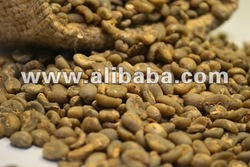Coffea arabica is a species of Coffea originally indigenous to the mountains of the southwestern highlands of Ethiopia. It is also known as the "coffee shrub of Arabia", "mountain coffee" or "arabica coffee". Coffea arabica is believed to be the first species of coffee to be cultivated, being grown in southwest Arabia for well over 1,000 years.
It is said to produce better coffee than the other major commercially grown coffee species, Coffea canephora (robusta), but tastes vary. C. arabica contains less caffeine than any other commercially cultivated species of coffee.
Wild plants grow to between 9 and 12 m (29 and 39 ft) tall, and have an open branching system; the leaves are opposite, simple elliptic-ovate to oblong, 6–12 cm (2.4–4.8 in) long and 4–8 cm (1.6–3.2 in) broad, glossy dark green. The flowers are white, 10–15 mm in diameter and grow in axillary clusters. The fruit is a drupe (though commonly called a "cherry"; interestingly, the plural form is simply "cherry" - used only when referring to the fruit of C. arabica - when referring to the actual cherry fruit, the appropriate plural is "cherries") 10–15 mm in diameter, maturing bright red to purple and typically contains two seeds (the coffee seeds).
Arabica Coffee Beans (Mandheling Super Grade, Grade1, 2 & 3, Sumatra DP Grade 1 & 2, Bali Grade 1 & 2 and etc)


 Verified Company
Verified Company

